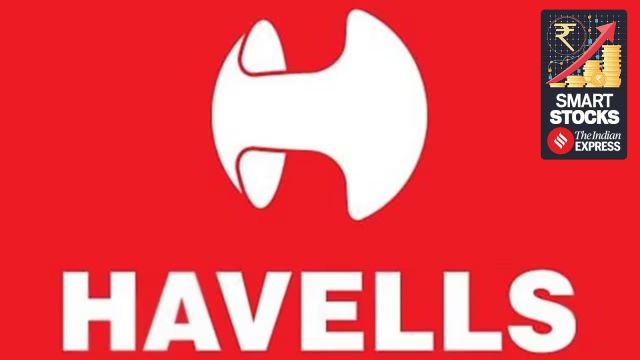5% revenue growth, 63x earnings: Is Havells’ premium valuation justified?
Despite solid performance in cables and steady growth in core categories, Havells’ Q2 was weighed down by a sharp slowdown in Lloyd, margin compression, and ongoing capital intensity. With Rs 3,000 crore invested in Lloyd and market share largely unchanged, the question is: is this valuation justified?
 Havells’ core businesses — cables, switchgear, lighting, and fans — are steady and profitable, with real competitive advantages. They are likely to grow at 8-12% per year with decent margins. (File image)
Havells’ core businesses — cables, switchgear, lighting, and fans — are steady and profitable, with real competitive advantages. They are likely to grow at 8-12% per year with decent margins. (File image)Havells India, the company that manufactures electrical products for residential, commercial and industrial use, posted one of its weakest quarters in years. Revenue grew just 5%. The stock has fallen 12% YTD while the broader market has gone up 9%. Brokerages are slashing earnings estimates.
And yet, the stock trades at 63 times its earnings.
So, investors are asking the question: Is this a quality company having a bad quarter, or is something fundamentally broken here?
Let’s find out.
What happened in Q2
The September quarter was challenging for Havells. Lloyd, the company’s air conditioning business, saw revenue crash 18% compared to last year. The profit margins of that business, technically called contribution margins, went from a healthy 14% to a measly 1.7%. Even the electrical consumer durables segment, which includes fans and coolers, fell 2%.
The reasons are straightforward. India experienced a shorter summer than usual, resulting in fewer people buying air conditioners. Then there was a huge inventory pile-up across the industry. In addition, new energy efficiency regulations are set to take effect from January 2026, which means companies need to clear their old inventory fast. And when you need to sell things fast, you discount aggressively, which impacts your margins.
This could look like a temporary setback — bad weather, inventory issues, and regulatory change. However, it is worth noting that Havells bought Lloyd in 2017 for Rs 1,600 crore, and despite the investment, Lloyd is still the third-largest air conditioner brand in India, the same position it had held when Havells bought it.
So the broader question is not just whether this was a weak quarter, but whether the acquisition has delivered the expected long-term value.
The case for optimism
There are positives as well.
First, while Lloyd and consumer durables struggled, Havells’ cables business absolutely crushed it. Revenue grew 12%, and margins jumped from 12.3% to 17.7% year-on-year. This business is riding the wave of infrastructure spending and real estate demand. When the government is building roads, metros, and airports, somebody needs to supply the cables. Havells is often that somebody.
Second, the management is confident that this inventory problem is temporary. They expect channel inventory to normalise by the end of December, and overall working capital should stabilise by March.
Third, Havells is making a smart bet on premiumisation. About 40% of their fan portfolio now uses BLDC technology, which is more energy-efficient and commands higher margins. They’re launching AI-powered air conditioners and designer lighting products. The idea is simple: stop competing on price and start competing on features and quality. Premium products mean better margins, which means better profitability in the long run.
Fourth, the manufacturing investments are starting to pay off. Havells has built new cable plants, expanded AC capacity from 2 million to 3 million units, and is setting up facilities for manufacturing washing machines and refrigerators. When you control your own manufacturing, you have better control over quality, costs, and supply chains. That’s a real competitive advantage.
 Havells has Rs 3,000 crore tied up in Lloyd.
Havells has Rs 3,000 crore tied up in Lloyd.
Havells has quietly been widening its reach. Its dealer network has grown at a steady 12.7% CAGR from FY16 to FY25. The retailer network has also doubled in size — from about 1 lakh outlets in FY16 to nearly 2.6 lakh in FY25, growing at 11.6% annually. And while it was doing all this, Havells kept strengthening its on-ground force too. Its electrician network has gone from 1.5 lakh to over 3 lakh in the same period.
You can have the best product in the world, but if it’s not available at your local hardware store or if the electrician doesn’t recommend it, you’re not selling much. Havells has that distribution muscle, and it’s not easy to replicate.
From this perspective, Havells looks like a fundamentally strong company navigating some challenges. The core businesses are solid, the distribution is unmatched, and the manufacturing investments will drive efficiency.
The case for caution
Now let’s look at the other side.
Start with the Lloyd business. Havells paid Rs 1,600 crore to acquire Lloyd. It spent another Rs 400 crore building a plant in Andhra Pradesh, Rs 60 crore expanding capacity, and continued to invest in marketing, dealer incentives, and working capital. Altogether, the company has invested roughly Rs 2,100 crore over eight years. But despite this, the business is ranked third in market share and posted a contribution margin of only 1.7%.
This pressure on margins isn’t entirely new. Lloyd’s contribution margin has declined from 13.7% in Q2 FY21 to 1.7% in Q2 FY26. That suggests the challenge extends beyond a weak summer or regulatory changes. The business has historically operated on thinner margins and relied on higher volumes.
There’s also the question of capital efficiency. Havells has Rs 3,000 crore tied up in Lloyd. Those funds might have generated stronger returns if allocated to the cables business, which continues to perform well, or returned to shareholders. Instead, the capital remains committed to a low-margin, capital-intensive business that has not significantly changed its market position over the past eight years.
Another layer to consider is valuation. At 46 times earnings, investors are paying a premium multiple for a company that delivered 5% revenue growth and is seeing earnings estimates trimmed by 3-6%. It raises the question of whether the current price adequately reflects these uncertainties.
Havells’ core businesses — cables, switchgear, lighting, and fans — are steady and profitable, with real competitive advantages. They are likely to grow at 8-12% per year with decent margins.
The main concern is the Lloyd segment. At around 63 times earnings, Havells appears to combine strong core operations with a premium valuation, while also carrying the uncertainties associated with Lloyd. The key question is: at what valuation does this overall mix become attractive?
The bottom line
Havells isn’t a distressed business, and nothing suggests the fundamentals are broken. But it also doesn’t appear to be an obvious value opportunity. It’s essentially a “show me” story: management needs to demonstrate that Lloyd can deliver consistent profitability, that working capital efficiency can improve, that the premium product strategy can boost margins, and that past capital allocation lessons have been absorbed.
Until there is clearer evidence on these fronts, paying around 63 times earnings requires a degree of confidence that may not be fully justified. The distribution network and brand equity are strong, and the core businesses continue to perform. But at this valuation, given the near-term challenges and the drag from Lloyd, the stock doesn’t look especially cheap.
In some cases, it can be prudent to monitor how the story unfolds and wait for a more balanced risk-reward opportunity.
Note: We have relied on data from http://www.Screener.in throughout this article. Only in cases where the data was not available, have we used an alternate, but widely used and accepted source of information.
Sonia Boolchandani is a financial content writer.
Disclosure: The writer and his dependents do not hold the stocks discussed in this article.
The website managers, its employee(s), and contributors/writers/authors of articles have or may have an outstanding buy or sell position or holding in the securities, options on securities or other related investments of issuers and/or companies discussed therein. The content of the articles and the interpretation of data are solely the personal views of the contributors/ writers/authors. Investors must make their own investment decisions based on their specific objectives, resources and only after consulting such independent advisors as may be necessary.



- 01
- 02
- 03
- 04
- 05




























